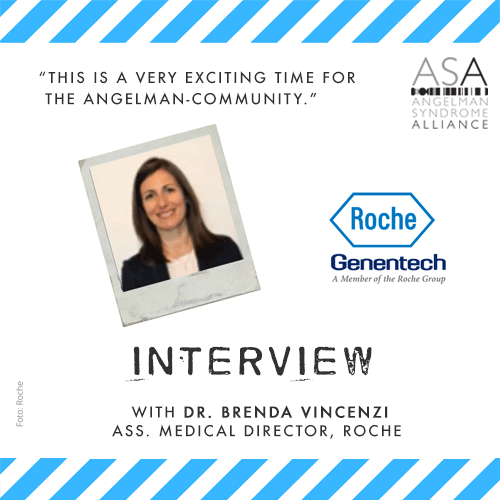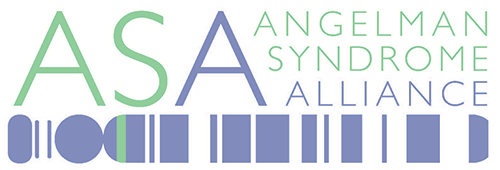pdf Brenda Vincenzi (Roche) Popular
By Administrator 673 downloads

In conversation with Brenda Vincenzi, MD Together with its American "subsidiary" Genentech and other partners, Roche is the largest biotech company in the world. Since 2015, the pharmaceutical giant has been dedicated to Angelman syndrome with its own program. According to FREESIAS, an observational study on Angelman syndrome, the company will start the ASO therapy study TANGELO (Targeting Angelman Syndrome with an oligo-nucleotide) in the summer. Reason enough for us to ask Brenda Vincenzi, MD (Ass. Medical Director, Roche):
When did you first come into contact with Angelman syndrome?
I trained in neuropsychiatry and worked with children 0-17 yo with diverse neurodevelopmental and neuropsychiatric disorders. In 2014, during my first year of residency, I was asked to evaluate a 12- month-old girl because of developmental delay. Although the pediatrician initially tried to reassure the family, the mother knew that something was not right. It did take a few weeks to confirm the diagnosis, Angelman syndrome. It is impossible to forget the tears of the little girl’s mother while I communicated the diagnosis and answered that no, there was no treatment available for their little girl.
What makes Angelman syndrome interesting for you from a scientific point of view?
I would like to cite dr. Art Beaudet, a professor at Houston’s Baylor College of Medicine: “Compared to 30 other paediatric neurological disorders, I would make the case that Angelman syndrome holds one of the single most optimistic possibilities for a treatment”. The biology of AS almost calls out for intervention and at Roche we are very excited to be able to act on it. Although there are current knowledge gaps around our understanding of the disease, Angelman syndrome can function as a model that allows researchers to investigate the complexity of neurodevelopment and brain maturation.
How do you assess the future of drug treatment for Angelman syndrome?
I want to look at the future with optimistic eyes. This is a very exciting time for the Angelman community as many have decided to invest in better understanding AS. It is important that we continue to work together with patients’ organizations, families, clinician and researchers, health authorities and pharma companies to build the bridge of knowledge around AS and achieve something meaningful for patients and their families.
"I stand up for AS research because we need to bring more attention to neurogenetic disorders like Angelman Syndrome and to advance this field of research in order to offer patients and their families meaningful treatment options.“
What do you expect from the clinical studies concerning ASO therapy? How can Angelman patients benefit from ASO therapy?
Roche listens and learns from the AS community and works to identify what is truly important for patients and their families. Our goal is to bring to the market a therapy that will address all the symptoms of the underlying disease. We are optimistic that our ASO therapy will be truly disease modifying, which would not only improve the health and wellbeing of affected children but also improve the quality of life for entire families. Moreover, our target at Roche is to include in our future clinical trials all ages and all genotypes.
What do you expect of the gene therapy, concerning AS treatment? How do you assess the chances and risks of this treatment?
Gene therapy is an exciting field that on one hand has a track record of troubling setbacks but on the other has incredible potential for curing a plethora of genetic disorders in different disease areas. Given that AS is a monogenic disorder, the likelihood of reaching a successful form of gene therapy is, in my opinion, high.
What are the risks associated with ASO therapy for Angelman syndrome?
Our Roche ASO treatment went through a very strict selection process. More than 2,300 molecules were screened and the most potent and safest LNA was selected for our clinical development program. In animals’ experiments our drug was safe and well tolerated so that we do not expect any significant side effect from the drug.
How do you rate the development opportunities of "full-grown Angelman brains“?
At Roche, we always look at the big picture, which means including in our clinical development plans all ages whenever possible. Although animal studies have shown that the impact of a treatment could have different effects when provided to younger or older animals, we currently do not know how this works in humans. This makes this study very important, as the learnings will be used to provide hopeful treatment opportunities to patients of all ages and with all genotypes.
Are there any (comparative) studies that prove that an unused brain area has been reactivated after causal therapy?
As mentioned, we do not have any human data on the efficacy of our treatment in AS individuals. Nevertheless it was recently that reinstatement of Ube3a in adult mice rescues the excitatory and inhibitory synaptic deficits in the pre-frontal cortex, supporting the idea that UBE3A restoration leads to a change in cortical circuit activity demonstrated (Rotaru et al. Adult Ube3a Gene Reinstatement Restores the Electrophysiological Deficits of Prefrontal Cortex Layer 5 Neurons in a Mouse Model of Angelman Syndrome. The Journal of Neuroscience: the official journal of the Society for Neuroscience 2018;38:8011-30).
Is there anything you want to say to the AS-families?
I am a clinician by training but also a mother of two. I want you all to know that the AS Roche team is working non-stop with one goal in mind: to bring you and your children a meaningful treatment that will improve the quality of life of your child and of the whole family.






